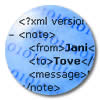
XML stands for EXtensible Markup Language.
XML was designed to transport and store data.
In this tutorial you will learn about XML, and the difference between XML and HTML.
XML is important to know, and very easy to learn.
From http://www.w3schools.com (Copyright Refsnes Data)

 |
XML stands for EXtensible Markup Language. XML was designed to transport and store data. In this tutorial you will learn about XML, and the difference between XML and HTML. XML is important to know, and very easy to learn. |
Learn by examples! With our editor, you can edit XML and click on a test button to view the result.
Test your XML skills at W3Schools!
 |
Get Your Diploma!W3Schools' Online Certification Program is the perfect solution for busy professionals who need to balance work, family, and career building. The HTML Certificate is for developers who want to document their knowledge of HTML, XHTML, and CSS. The JavaScript Certificate is for developers who want to document their knowledge of JavaScript and the HTML DOM. The XML Certificate is for developers who want to document their knowledge of XML, XML DOM and XSLT. The ASP Certificate is for developers who want to document their knowledge of ASP, SQL, and ADO. The PHP Certificate is for developers who want to document their knowledge of PHP and SQL (MySQL). |
Introduction to XML
What is XML, and how does it differ from HTML?
How XML can be used
Some of the different ways XML can be used.
XML Tree
How an XML document forms a logical tree structure.
XML Syntax
The logical and very simple syntax rules of XML.
XML Elements
XML Elements, naming rules, and their parent and child relationships.
XML Attributes
How
attributes can be used to provide additional information
about
elements.
XML Validation
The difference between a well-formed and a valid XML document, and how to
specify the structure of an XML document.
XML Validator
A simple on-line tool for syntax-checking (validating) XML.
Viewing XML in Browsers
How to view XML files with your browser.
Displaying XML with CSS
How to use CSS to display an XML file.
Displaying XML with XSLT
How to use XSLT to display an XML file.
XML Parser
How to use your browser to read, update, create, and manipulate XML documents.
XML DOM
About XML Document Object Model (The DOM).
XML to HTML
How to display XML data inside HTML documents.
XML HTTP Requests
How to update a page with data from a server without reloading the page (AJAX).
XML Applications
How to use XML data and JavaScript to
create a complete HTML application.
XML Namespaces
How XML namespaces can be used to avoid element name conflicts.
XML CDATA
How store invalid XML data inside a valid XML document.
XML Encoding
How to use different character sets in your XML documents.
XML Server
How to output XML from the server.
XML DOM Advanced
More about XML Document Object Model (The DOM).
XML Don't
This chapter describes some technologies you should try to avoid when using XML.
XML Technologies
The most common
XML-related languages.
XML in Real Life
Real-life examples of how XML can be used.
XML Editors
Why you should use an XML editor when you edit your XML documents.
XML Summary
This chapter contains a summary on what you have learned in this tutorial and a recommendation on what
to do
next.
From http://www.w3schools.com (Copyright Refsnes Data)